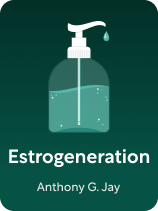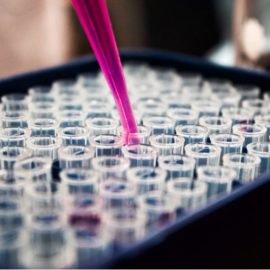

This article is an excerpt from the Shortform book guide to "Estrogeneration" by Anthony G. Jay. Shortform has the world's best summaries and analyses of books you should be reading.
Like this article? Sign up for a free trial here.
What are the effects of estrogenics? Do estrogenics affect your weight?
Endocrine disruptors can harm human and environmental health, according to Anthony G. Jay. Estrogenics—a type of endocrine disruptor—contributes to obesity, depression, hormone imbalance, immune system dysfunction, cancer, and infertility.
Let’s explore each of these estrogenic side effects in more detail.
1. Obesity
Jay argues that increasing rates of obesity in the US can be an estrogenic side effect. He explains why: Estrogenics are lipophilic (fat-loving) and hydrophobic (water-repelling), which makes them attracted to fat cells. Once they’ve been absorbed into fat cells, they stimulate fat growth by activating a protein called PPARγ, which controls the formation and growth of fat cells. They can cause an excessive activation of this protein, leading to greater fat accumulation. Research has shown that estrogenics can also induce insulin resistance, which can cause obesity.
Estrogenics’ attraction to fat has another ramification as well: Upon reaching these cells, estrogenics tend to remain there, contributing to long-term effects on our health.
| How PPARγ and Insulin Resistance Affect Your Body Other experts elaborate on the role of PPARγ in our bodies: It not only affects the growth and functioning of fat cells, but also of different immune system cells, and even some other tissues, like those found in the colon and bladder. In The Obesity Code, Jason Fung explains that insulin resistance—commonly caused by poor diets and eating habits—is when your body needs more insulin to deliver glucose for energy. Insulin resistance causes obesity because your body has a “set weight”—a default body weight that it tries to maintain by storing or burning fat. Chronically high insulin levels can increase this set weight, causing the body to accumulate more fat than it needs, leading to obesity. |
2. Depression
Jay writes that research also suggests potential links between estrogenics and depression. While definitive research linking the two is elusive due to the complex nature of depression, multiple studies hint at the depressive impact of estrogenics.
(Shortform note: Psychologists argue that depression is a challenging condition to measure due to its deeply personal and individual nature. Currently, there are dozens of methods for assessing depression that mainly use a checklist-based system, scoring various symptoms such as trouble sleeping, weight loss, or an overall depressed mood. Psychologists argue that these existing tools fail to capture the complexity of depression, which manifests differently across diverse populations. For instance, racial and ethnic minorities often experience symptoms not traditionally included in assessments.)
Jay mentions several studies indicating a causal link between estrogenics and depression. One study found that women who consume oral contraceptives appear to have a higher incidence of suicide. Another study found a significant increase in suicide rates among Indian farmers who were likely using atrazine on their crops. Other estrogenics like BPA and phthalates have also been linked to depression, with research showing that BPA can activate a biomarker for depression.
(Shortform note: Research suggests that teenagers may be more at risk than adults for developing depressive symptoms from being exposed to estrogenics. A 2023 study found that teenagers taking oral contraceptives have a 130% higher incidence of depression symptoms compared to 92% in adults. Similarly, another study found that adolescents living in agricultural communities who are exposed to higher levels of pesticides have greater depression symptoms—especially in younger, female adolescents.)
3. Hormone Imbalance
Jay also discusses another health issue associated with estrogenics: the declining rates of testosterone among men and women across the world. While testosterone levels have been declining naturally over thousands of years, there’s been a steep drop in recent history.
Testosterone plays a critical role in the development and maintenance of your physical and mental health, influencing your sex drive, muscle mass and strength, bone density, mood, energy levels, and general well-being. Testosterone and estrogen (along with estrogenic compounds) also affect the brain’s neuroplasticity—its ability to reorganize itself by forming new neural connections.
Jay writes that estrogenics reduce the amount of usable testosterone in your body. To understand how, let’s first discuss how testosterone travels within your body and what usable testosterone is: Testosterone and estrogen are hydrophobic, so they need the help of a non-hydrophobic protein to travel through your bloodstream (which is mostly water). As a result, the majority of testosterone in your body binds to this protein—known as sex hormone-binding globulin (SHBG)—and isn’t readily usable by the body. However, a small percentage of testosterone remains unbound in your bloodstream as free testosterone, which is the most usable form for your body.
Jay explains that estrogenics lower your free testosterone levels in three ways: They increase the amount of SHBG in your blood, reduce the number of testosterone receptors in your body, and block testosterone from binding to receptors. This leads to two major problems:
1. Precocious puberty. The onset of puberty is occurring earlier than ever before (especially for girls), which can lead to psychological and physical health problems.
2. The “feminization of males.” Hormonal disruptions reduce motivation specifically in men. Jay writes that this may explain the reason that participation in boy’s sports is falling nationwide and that more women are enrolling in universities than men.
4. Immune System Dysfunction
Jay writes that estrogenics can cause immune system dysfunction by confusing our immune cells, causing them to attack healthy body parts while also preventing them from combating harmful agents like bacteria and viruses. This leads to allergies, skin disorders, autoimmune diseases, and even cancers.
(Shortform note: Your immune system’s main purpose is to defend your body. There are three ways your immune system may not function properly: It may be weak, overactive, or it may turn against you. Having an overactive immune system means it reacts to harmless substances, resulting in conditions like asthma, eczema, and allergic rhinitis. Autoimmune diseases are when your immune system attacks your body’s healthy tissues, resulting in conditions like Type 1 diabetes, rheumatoid arthritis, and lupus.)
Jay adds that estrogenics can also cause cancer because they attach to receptors that then directly bind to DNA, potentially causing damage. He explains that cancers occur when damage to DNA results in one or more mutations on genes that affect cell growth and development.
(Shortform note: In The Cancer Code, Jason Fung writes that cancer is almost always the result of carcinogens, which are environmental factors that damage or destroy cells. Thus, estrogenics can be considered as carcinogens alongside widely recognized carcinogenic substances like tobacco, asbestos, and radiation.)
5. Infertility
Jay also suggests that estrogenics can potentially cause infertility in men and women. He points to two ways this happens. First, estrogenics directly damage sexual organs and interfere with their normal functions. Second, estrogenics can cause harm to embryos, leading to developmental issues or even death.
A large-scale study across a range of animals, including different types of fish, rodents, and mammals, showed worrying signs of falling fertility rates linked to exposure to these chemicals. For instance, researchers found that ZEA triggers severe abnormalities in the reproductive systems of female pigs, leading to a host of issues in their unborn offspring.
While human-specific research linking estrogenics to infertility is limited, Jay advises avoidance of these chemicals. He explains that researching the direct impact of these chemicals on human fertility is difficult due to the lengthy nature of fertility studies and the challenge of establishing a pure control group, as many people already have high levels of these estrogenic substances in their bodies.
| What Is Infertility, and How Is It Treated? Infertility is defined by the inability to achieve a pregnancy after at least one year of unprotected sex. In addition to estrogenics (and other environmental toxins), infertility can be linked to various other factors. In men, risk factors include obesity, excessive alcohol or drug use, and genetic disorders. In women, risk factors include smoking, alcohol use, extreme weight gain or loss, and physical or emotional stress. While one in six people are affected by infertility across the globe, data doesn’t suggest that a build-up of estrogenics is worsening this problem. In fact, research shows that infertility rates have remained largely the same in the US for about two decades. Steering clear of estrogenics may be a wise precaution. But for those already struggling with infertility, there are various fertility treatment options available. In roughly 90% of cases, infertility can be treated. |

———End of Preview———
Like what you just read? Read the rest of the world's best book summary and analysis of Anthony G. Jay's "Estrogeneration" at Shortform.
Here's what you'll find in our full Estrogeneration summary:
- How estrogenics are causing a rise in health problems
- How to avoid estrogenics and detoxify your body
- Why you shouldn't eat foods packed in plastic packaging or cans






